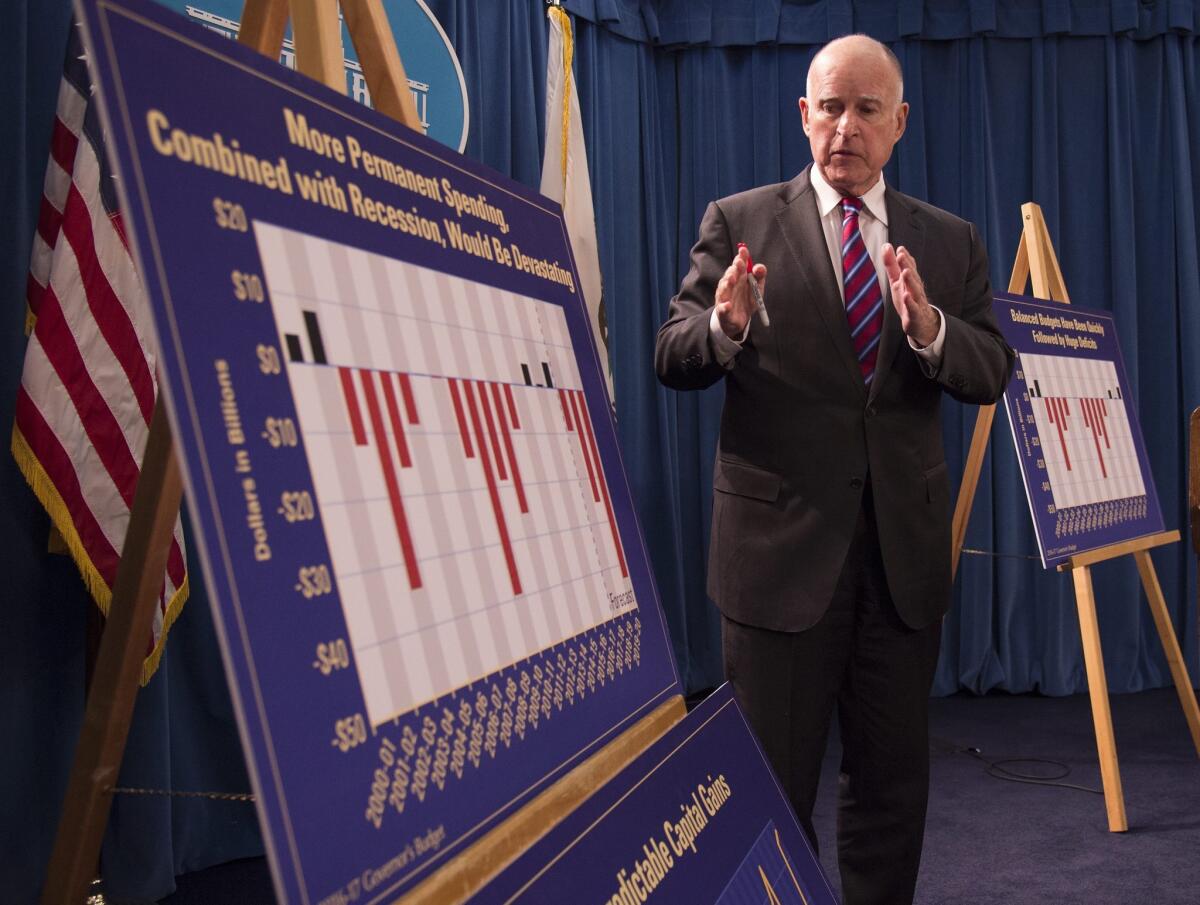Column: Political Road Map: Surprisingly, talk in Sacramento could return to a firm cap on state spending

Sacramento — During California’s biggest state budget fights, many of which played out in the shadow of monster deficits, lawmakers clashed mightily over this question: Were the state’s problems a result of too little cash or too much spending?
Those who believed it was a cash problem seem to have prevailed. But don’t be surprised if that victory rings a bit hollow before the end of 2017.
The battles faded after voters made it easier to pass budgets and California’s economy started growing again. Additional dollars came from from two ballot measures, in 2012 and 2016, that imposed a temporary surcharge on the income taxes paid by the state’s most wealthy residents.
But relying on taxes paid by high-income earners can be like riding a revenue roller coaster. And when it plunged California deep into budget red ink, fiscal conservatives insisted the lesson was that lawmakers couldn’t be trusted to do what’s right.
“We don’t have a revenue problem, we have a spending problem,” said former Gov. Arnold Schwarzenegger in his 2005 State of the State address, a phrase borrowed from Republican legislators.
When they suggested a new constitutional amendment to prevent overspending, Schwarzenegger championed a 2005 ballot measure to do just that. Voters, though, rejected it. They also said no to a modified spending restraint in 2009.
Political Road Map: Does the state budget spend more on schools or prisons? »
Fast forward to 2014, when a Democratic governor convinced voters to expand the state budget’s rainy day fund. “I’ve been around long enough to know that the pendulum always swings in California,” said Gov. Jerry Brown in a campaign commercial that year. “Prop. 2 sets aside money to prepare us for economic storms.”
No one ever called Proposition 2 a spending cap, but it certainly has operated like one. After all, more money saved for the future means less that’s available to spend now. Last summer, Brown and lawmakers crafted one of their most cautious budgets, stashing away $2 billion more than was legally required.
Because Proposition 2 has rather strict rules for dipping into the rainy day fund, last year’s decision was tantamount to imposing a rigid cap on spending for last year. The person who can lift that cap this year, the governor, seems unlikely to do so — even after he sounded the alarm this winter on a $1.6-billion budget deficit, the first deficit in four years. That means the eventual solution will come from — surprise — reduced spending.
The real surprise, though, may be the news that landed last week in Sacramento. As it turns out, there’s an existing spending cap most people had forgotten about.
A report by the independent Legislative Analyst’s Office warned budget expenses may be creeping close to the spending limits enshrined in the California Constitution in 1979, and loosened 11 years later to accommodate funding for public schools. The resulting cap has almost always been a lot higher than actual spending levels, but the new analysis suggests a growing economy is quietly taking up the remaining space. Brown’s team disputes that conclusion, but don’t be surprised if the issue ends up in court.
For the Legislature’s majority Democrats, the cap issue is likely to linger over budget deliberations in May and June. Most of them were elected in the years since those tense spending cap debates, and could be surprised by what’s in store.
Follow @johnmyers on Twitter, sign up for our daily Essential Politics newsletter and listen to the weekly California Politics Podcast
ALSO:
Gov. Jerry Brown’s definition of a state spending limit could be flawed, say analysts
Political Road Map: There are more than 15 lobbyists for each legislator in Sacramento
Updates on California politics
More to Read
Get the L.A. Times Politics newsletter
Deeply reported insights into legislation, politics and policy from Sacramento, Washington and beyond. In your inbox three times per week.
You may occasionally receive promotional content from the Los Angeles Times.











